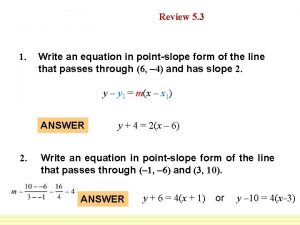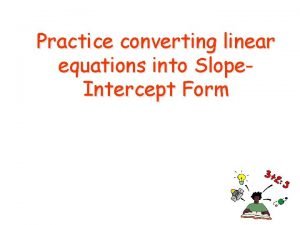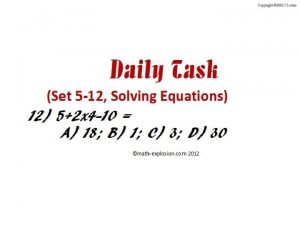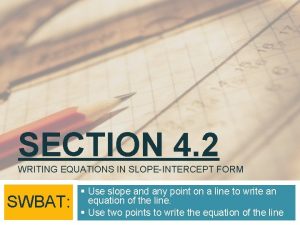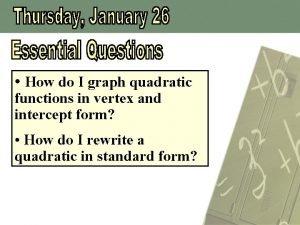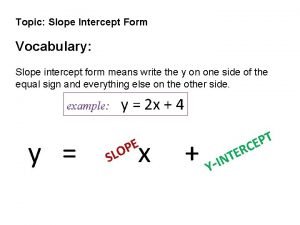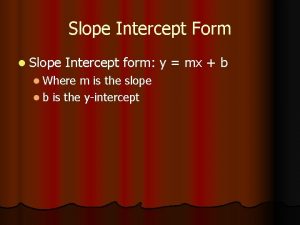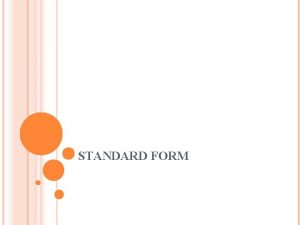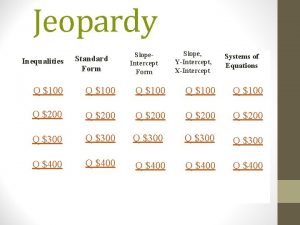EXAMPLE 5 Change from intercept form to standard









- Slides: 9

EXAMPLE 5 Change from intercept form to standard form Write y = – 2 (x + 5) (x – 8) in standard form. y= = – 2 (x + 5) (x – 8) – 2 (x 2 – 8 x + 5 x – 40) – 2 (x 2 – 3 x – 40) – 2 x 2 + 6 x + 80 Write original function. Multiply using FOIL. Combine like terms. Distributive property

EXAMPLE 6 Change from vertex form to standard form Write f (x) = 4 (x – 1)2 + 9 in standard form. f (x) = = = 4(x – 1)2 + 9 4(x – 1) + 9 4(x 2 – x + 1) + 9 4(x 2 – 2 x + 1) + 9 4 x 2 – 8 x + 4 + 9 4 x 2 – 8 x + 13 Write original function. Rewrite (x – 1)2. Multiply using FOIL. Combine like terms. Distributive property Combine like terms.

GUIDED PRACTICE for Examples 5 and 6 Write the quadratic function in standard form. 9. y = – (x – 2) (x – 7) y= = – (x – 2) (x – 7) – (x 2 – 7 x – 2 x + 14) – (x 2 – 9 x + 14) – x 2 + 9 x – 14 Write original function. Multiply using FOIL. Combine like terms. Distributive property

GUIDED PRACTICE for Examples 5 and 6 10. y = – 4(x – 1) (x + 3) y= = – 4(x – 1) (x + 3) – 4(x 2 + 3 x – 3) – 4(x 2 + 2 x – 3) – 4 x 2 – 8 x + 12 Write original function. Multiply using FOIL. Combine like terms. Distributive property 11. f(x) = 2(x + 5) (x + 4) = 2(x 2 + 4 x + 5 x + 20) = 2(x 2 + 9 x + 20) = 2 x 2 + 18 x + 40 Write original function. Multiply using FOIL. Combine like terms. Distributive property

GUIDED PRACTICE for Examples 5 and 6 12. y = – 7(x – 6) (x + 1) y= = – 7(x – 6) (x + 1) – 7(x 2 + x – 6) – 7(x 2 – 5 x – 6) – 7 x 2 + 35 x + 42 Write original function. Multiply using FOIL. Combine like terms. Distributive property

GUIDED PRACTICE for Examples 5 and 6 13. y = – 3(x + 5)2 – 1 = – 3(x + 5) – 1 = – 3(x 2 + 5 x + 25) – 1 = – 3(x 2 + 10 x + 25) – 1 = – 3 x 2 – 30 x – 75 – 1 = – 3 x 2 – 30 x – 76 Write original function. Rewrite (x + 5)2. Multiply using FOIL. Combine like terms. Distributive property Combine like terms.

GUIDED PRACTICE for Examples 5 and 6 14. g(x) = 6(x - 4)2 – 10 = 6(x – 4) – 10 = 6(x 2 – 4 x + 16) – 10 = 6(x 2 – 8 x + 16) – 10 = 6 x 2 – 48 x + 96 – 10 = 6 x 2 – 48 x + 86 Write original function. Rewrite (x – 4)2. Multiply using FOIL. Combine like terms. Distributive property Combine like terms.

GUIDED PRACTICE for Examples 5 and 6 15. f(x) = – (x + 2)2 + 4 = – (x + 2) + 4 = – (x 2 + 2 x + 4) + 4 = – (x 2 + 4 x + 4) + 4 = – x 2 – 4 x – 4 + 4 = – x 2 – 4 x Write original function. Rewrite (x + 2)2. Multiply using FOIL. Combine like terms. Distributive property Combine like terms.

GUIDED PRACTICE for Examples 5 and 6 16. y = 2(x – 3)2 + 9 = 2(x – 3) + 9 = 2(x 2 – 3 x + 9) + 9 = 2(x 2 – 6 x + 9) + 9 = 2 x 2 – 12 x + 18 + 9 = 2 x 2 – 12 x + 27 Write original function. Rewrite (x – 3)2. Multiply using FOIL. Combine like terms. Distributive property Combine like terms.
 Vertex form
Vertex form How to turn standard form into slope intercept
How to turn standard form into slope intercept Lesson 4-7 point slope form answer key
Lesson 4-7 point slope form answer key Converting to slope intercept form
Converting to slope intercept form Rewriting linear equations in slope intercept form
Rewriting linear equations in slope intercept form X intercept and y intercept
X intercept and y intercept 4-2 writing equations in slope-intercept form
4-2 writing equations in slope-intercept form Unit 2 linear equations
Unit 2 linear equations How to find the vertex
How to find the vertex How to write slope intercept form
How to write slope intercept form

